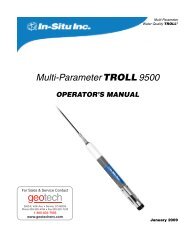TEST INSTRUCTIONS - Geotech Environmental Equipment
TEST INSTRUCTIONS - Geotech Environmental Equipment
TEST INSTRUCTIONS - Geotech Environmental Equipment
You also want an ePaper? Increase the reach of your titles
YUMPU automatically turns print PDFs into web optimized ePapers that Google loves.
COLLECTION & TREATMENT OF THE WATER SAMPLE<br />
Steps 1 through 4 below describe proper sampling technique in shallow water.<br />
For sample collection at depths beyond arm’s reach, special water sampling<br />
apparatus is required (e.g. the LaMotte Water Sampling Chamber, Code 1060;<br />
Model JT-1 Water Samplers, Code 1077; Water Sampling Outfit, Code 3103;<br />
or Water Sampling Bottle, Code 3-0026).<br />
1. To avoid contamination, thoroughly rinse the screw cap Sample Tube<br />
(29180) with sample water.<br />
2. Tightly cap Sample Tube and submerge to the desired depth. Remove cap<br />
and allow the Sample Tube to fill.<br />
3. Tap the sides of the submerged tube to dislodge any air bubbles clinging to<br />
the inside. Replace the cap while the Sample Tube is still submerged.<br />
4. Retrieve Sample Tube and examine it carefully to make sure that no air<br />
bubbles are trapped inside. Once a satisfactory sample has been collected,<br />
proceed immediately with Steps 5 and 6 to “fix” the sample.<br />
NOTE: Be careful not to introduce air into the sample while adding the<br />
reagents in steps 5 and 6. Simply drop the reagents into the sample. Cap<br />
carefully, and mix gently.<br />
5. Add 2 drops of *Manganese Sulfate Solution (4167) and 2 drops of<br />
*Alkaline Potassium Iodide Azide (7166). Cap and mix by inverting<br />
several times. A precipitate will form. Allow the precipitate to settle<br />
below the shoulder of the tube before proceeding.<br />
6. Add 8 drops of *Sulfuric Acid, 1:1 (6141WT). Cap and gently mix until<br />
the reagent and the precipitate have dissolved. A clear-yellow to<br />
brown-orange color will develop, depending on the oxygen content of the<br />
sample.<br />
NOTE: It is very important that all “brown flakes” are dissolved<br />
completely. If the water has a high DO level this could take several<br />
minutes. If flakes are not completely dissolved after 5 minutes, add 2 drops<br />
of *Sulfuric Acid 1:1 (6141WT) and continue mixing.<br />
NOTE: Following the completion of step 6, contact between the water sample<br />
and the atmosphere will not affect the test result. Once the sample has been<br />
“fixed” in this manner, it is not necessary to perform the actual test procedure<br />
immediately. Thus, several samples can be collected and “fixed” in the field,<br />
and then carried back to a testing station or laboratory where the test procedure<br />
is to be performed.<br />
Dissolved Oxygen 2/3 Smart2 <strong>TEST</strong> PROCEDURES 2.04

















